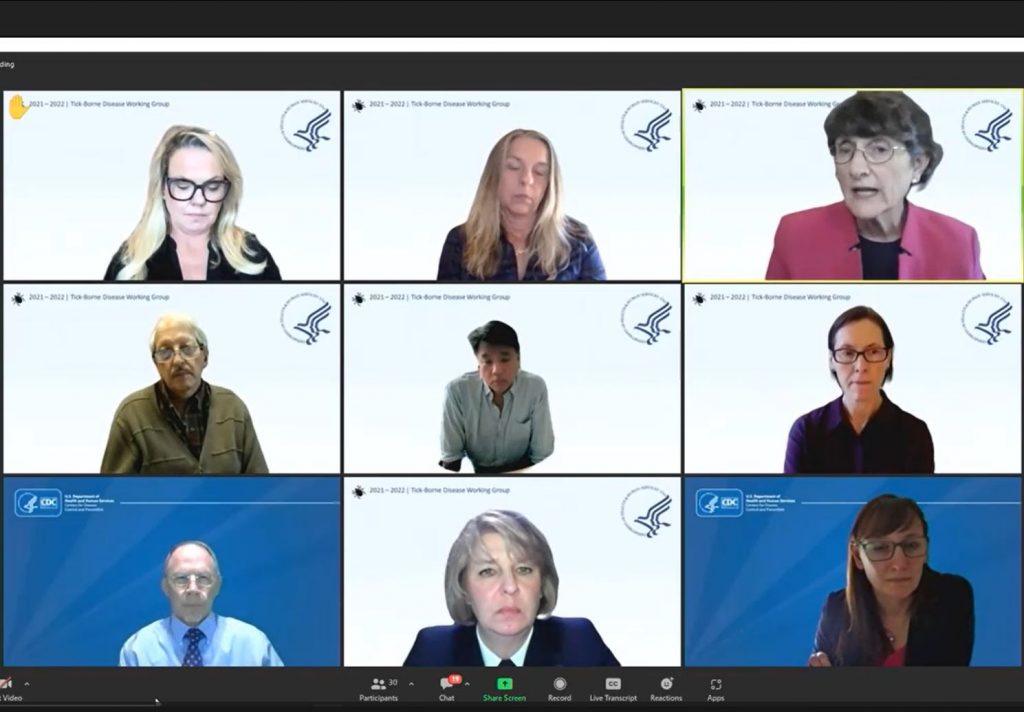After 6 years of TBDWG, are we still stuck with IDSA guidelines?

When I was watching last week’s online Tick-Borne Disease Working Group meetings, I got a sick feeling in my stomach.
It came at the end of the first day, when after hours of watching this stuff on my computer screen, my brain was turning to mush anyway.
Then, my ears perked up. Dr. Elizabeth Maloney—who ably represents the interests of Lyme patients and their treating doctors on this panel—asked a question of the CDC’s Sue Visser.
Earlier in the meeting, Visser had given a presentation about the US Department of Health and Human Services’ national strategy to combat vector-borne diseases (which the CDC plays a big role in).
Vector-borne diseases (VBD) include those carried by mosquitoes, fleas and ticks—so Lyme disease is part of that mix.
Maloney wanted to know more about the role of medical guidelines in the VBD strategy. Specifically, she asked if the agencies included public stakeholders in the process of developing guidelines.
“Yes, we do,” Visser answered firmly.
(Let me emphasize how important public input is to the Lyme community. For years, the CDC and other federal entities have endorsed the IDSA’s Lyme guidelines—which allow no meaningful input from public stakeholders while at the same time actively HARMING Lyme patients. The need for public input was a driving force in the Lyme community’s push for the formation of the TBDWG in the first place.)
When Maloney asked Visser to elaborate on the public input process, the CDC employee said:
There’s certain guidance that’s developed by other professional organizations and we rely upon them because they have convened the experts and they publish guidance and then we reference that guidance. In the area where there is not development by appropriate clinical professional society, for example, Rocky Mountain spotted fever, we waited and we put out clinical guidance for that…If we are developing from scratch the guidance, there’s actually a protocol for patient involvement, external feedback, external participation in the process…but in the case of an issue or disease where there is already lots of clinical interest and leadership, then we defer.
“Then we defer…”
That’s kind of wordy, don’t you think? Let me drill down to what she’s basically saying: The VBD national strategy will use the IDSA Lyme guidelines, period. Because, hey, they’re the experts. When they speak, then we defer…
Maloney tried to press the point about the IDSA guidelines not following accepted guidelines development practices (for example, allowing public input). But Visser sidestepped the question, and for the moment, the subject was dropped.
Getting back to that queasy feeling in my stomach: Have we really slogged through six years of Working Group effort, only to be stuck with the dangerous, anti-patient IDSA Lyme guidelines? (See: 10 things you should know about the IDSA Lyme guidelines.)
The CDC and its sister agencies have deferred to the IDSA’s Lyme guidelines for years now. That’s a huge factor in why Lyme patients can’t get the care they need. And a big reason that the CDC website continues to have inaccurate, damaging information on its Lyme-related web pages.
The Tick-Borne Disease Working Group is nearing the end of its run. As the current (third) iteration of the panel prepares to submit its Report to Congress in December, the big question is “what happens next?”
The TBDWG still has decisions to make. It convenes again on October 25.
Stay tuned.
TOUCHED BY LYME is written by Dorothy Kupcha Leland, Board President of LymeDisease.org. She is co-author of When Your Child Has Lyme Disease: A Parent’s Survival Guide. Contact her at dleland@lymedisease.org.




















We invite you to comment on our Facebook page.
Visit LymeDisease.org Facebook Page